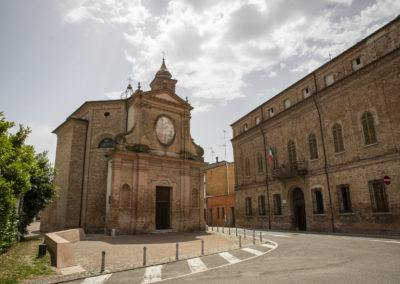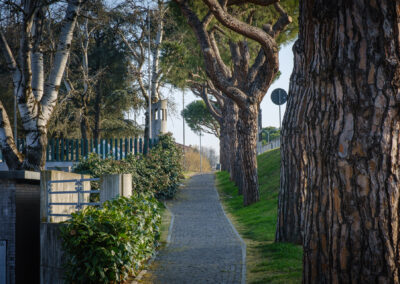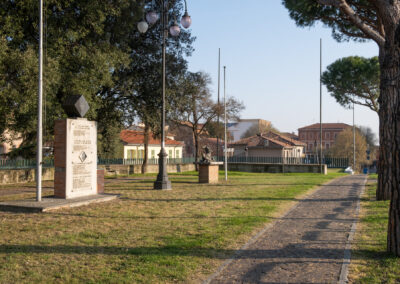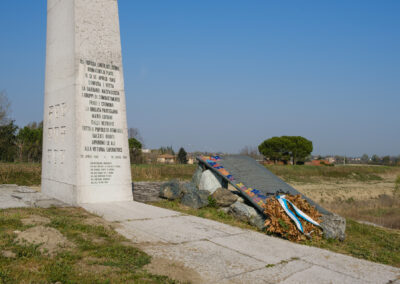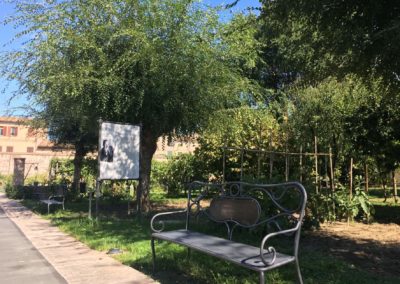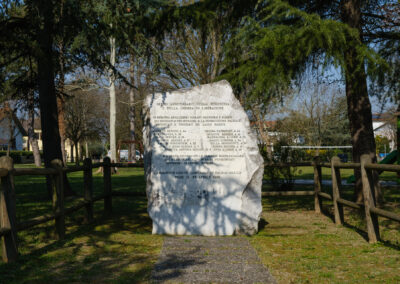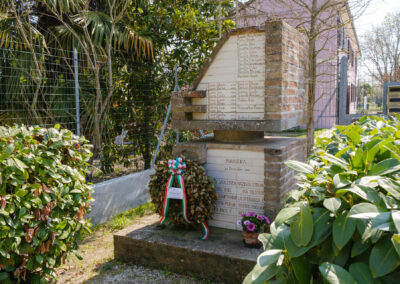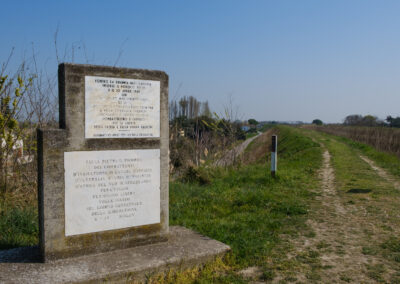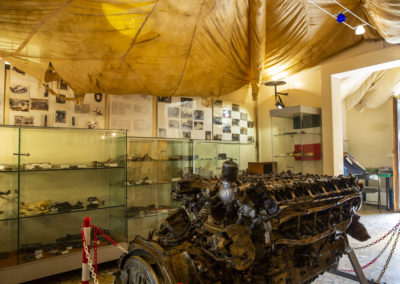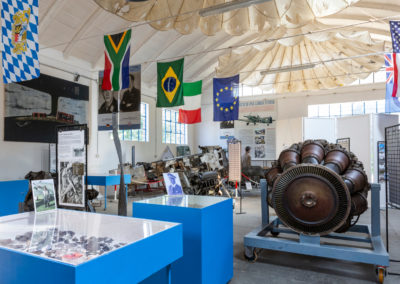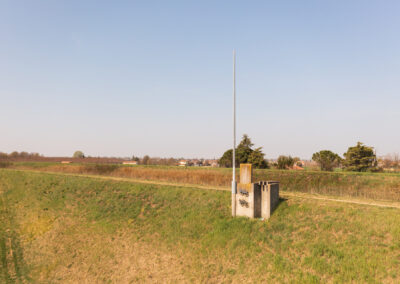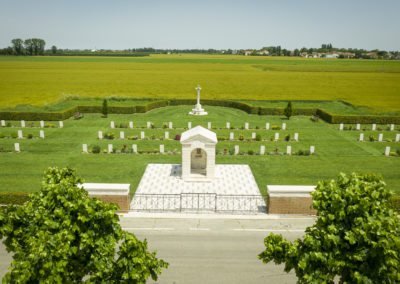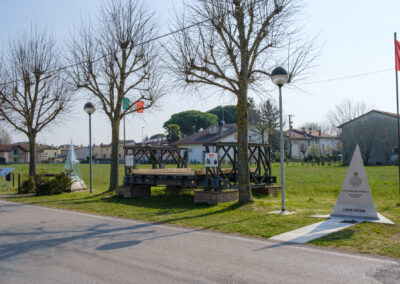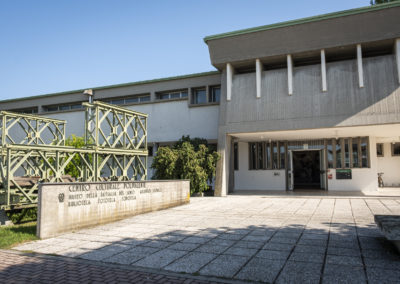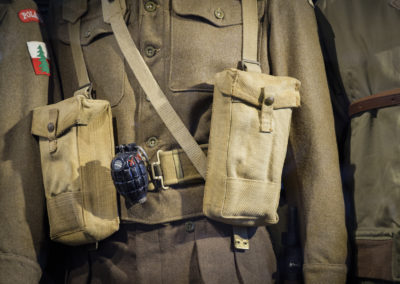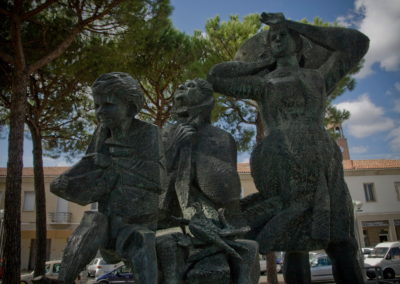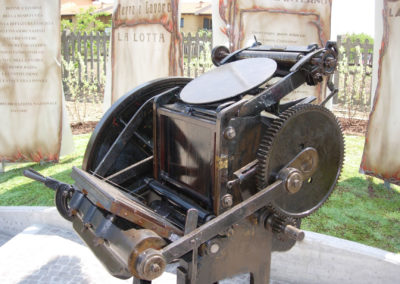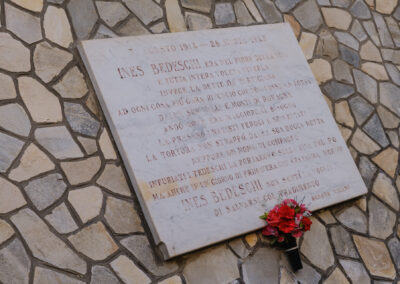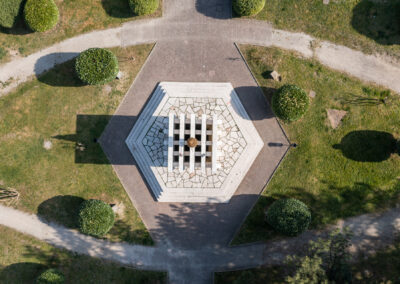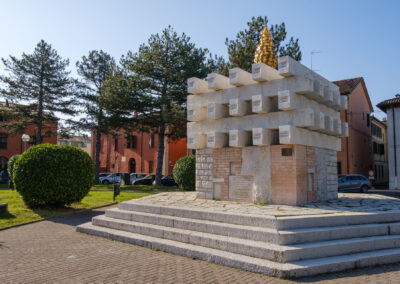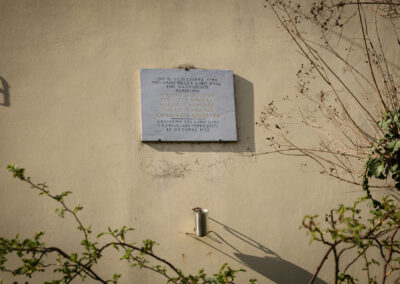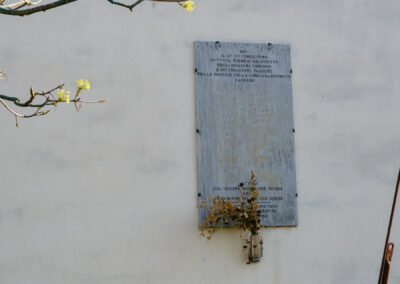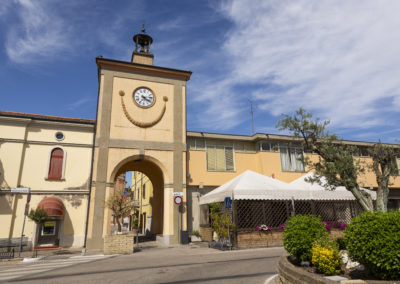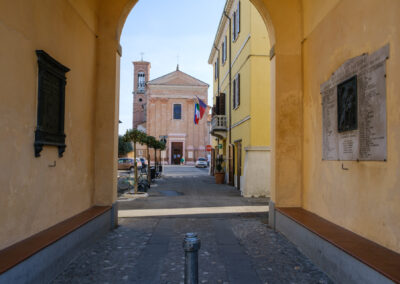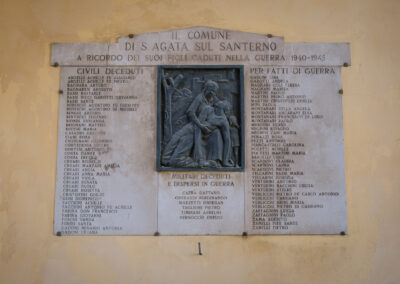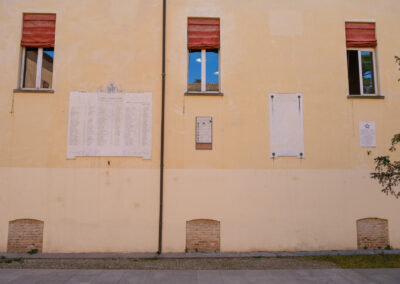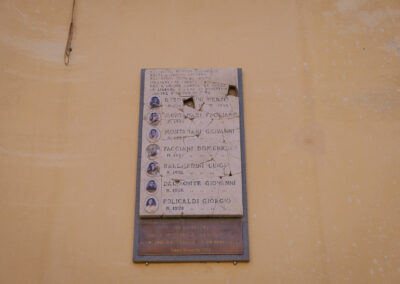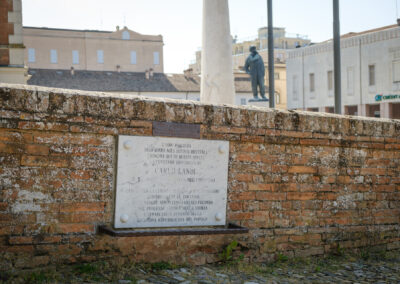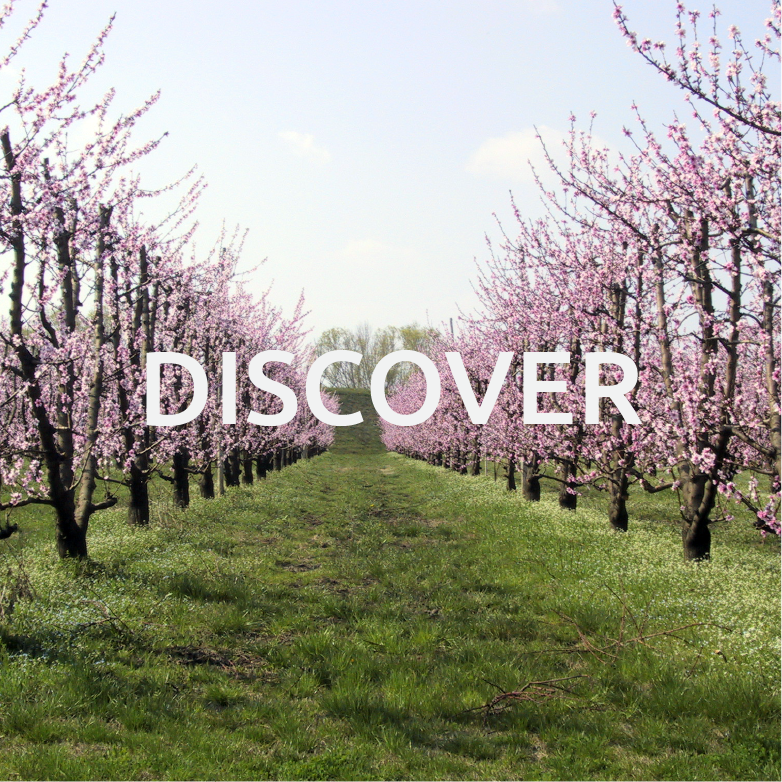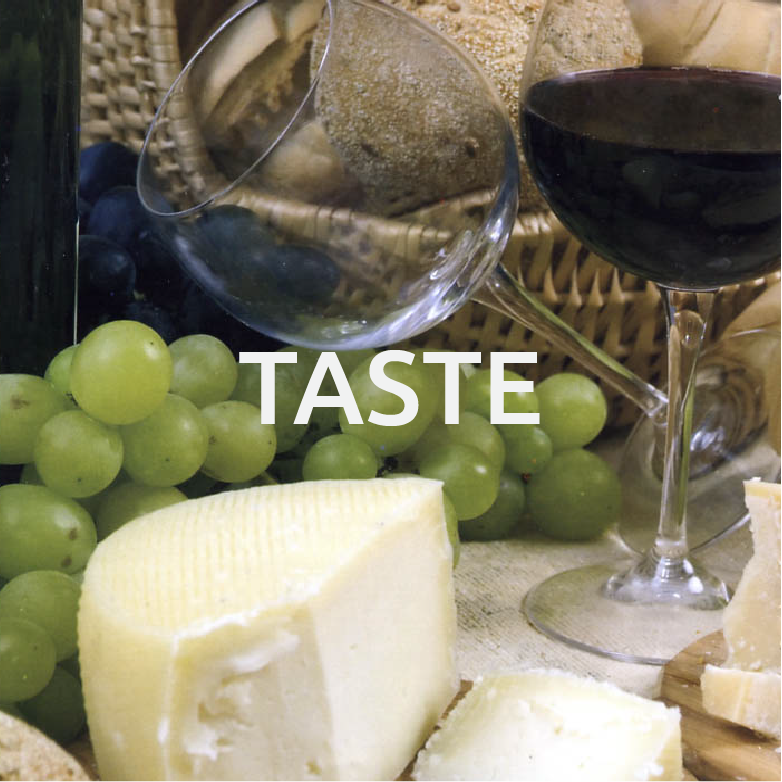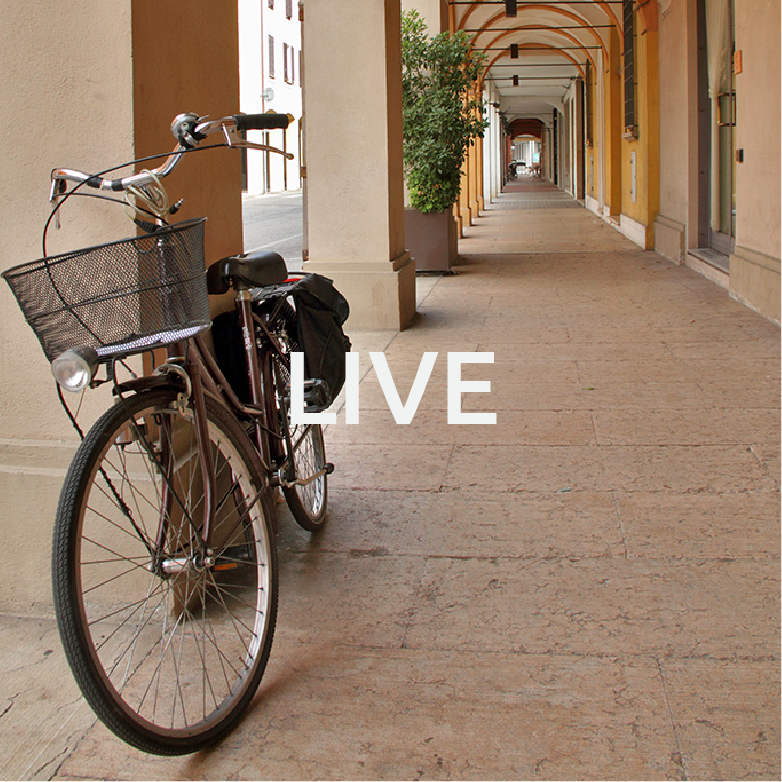In the heart of Romagna there is a strip of land, crossed by several waterways and important communication routes, that found itself to be a strategic territory during the last part of the Second World War. Inland, the small towns of Bassa Romagn, active during the Resistance, were victims of the harsh Nazi-Fascist repression, as witnessed by the memorial stones and plaques scattered along the embankments and in the countryside. Today, walking through these places, you can immerse yourself in a landscape that does not forget but spreads peace and serenity.
The route starts in Cotignola and continues along the embankment of the Senio river (or along adjacent roads if you are travelling by car) from which you can detour to Bagnacavallo, Fusignano and Villanova di Bagnacavallo, and then on to Alfonsine. From Alfonsine you cross the countryside to Conselice, reach Massa Lombarda and Sant’Agata sul Santerno, and then you arrive in Lugo, after a possible diversion to Bagnara di Romagna. Return to Cotignola.
You can travel by bike or by car following the directions on the map available at this link.
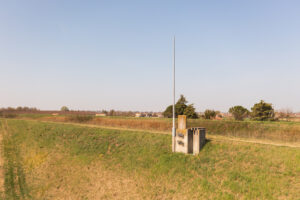
PRACTICAL INFO
INFO
- Interests: History, culture, territory
- Duration: 72 h
- Lenght: 72,6km
- Target: Cyclotourists, Friends, Couples, Groups
- When: All year round
ITINERARY
FIRST STOP
COTIGNOLA – Alfonsine (24,2 km) (18 km along the Senio river by bike)
The town of Cotignola is known as “The town of the Righteous Ones” because, between autumn 1943 and spring 1945, a number of Jewish families fleeing racial persecution found refuge there. All were saved from extermination thanks to a protection system that proved unique in Italy. A “system” made up of supportive families and municipal officials, who organised a real “network” made up of shelters and the supply of false documents that saved Jews, fugitives and politically persecuted people.
Starting from Piazzale della Pace in front of the Pio Suffragio church dedicated to the Fallen of all wars, where three large panels display photos of the destruction of the city, you can enter the Varoli Museum. This museum is dedicated to the artist Luigi Varoli “Righteous among the Nations”: on the second floor there is a section devoted to the Righteous ones with David Loom’s Frame room, an evocative installation of archive photos that appear like ghosts in the dark, together with historical documentation, publications and audiovisual material.
A few steps away from the museum, in the car park of Piazza Amendola, we find the Non-Automatic Distributor of Courage, a mural created in 2015 in an Enel cabin that represents, on a series of paintings and windows, some of the protagonists of those long 145 days when the front was positioned on the banks of the Senio river.
Proceeding towards the Senio river, in front of the bridge, is the Parco della Resistenza (Resistance Park), with the Monument dedicated to the allied soldiers from New Zealand who freed Cotignola; the memorial plaque of the “Bandiera Bianca” operation is on the back.
The murals along the Senio embankment were created in spring 2021 by the street artist About Ponny, on the occasion of the celebrations “Nel Senio della Memoria“.
Along the provincial road leading to Lugo, close to the river, we find the Giardino dei Giusti, where the Memorial Stele (1987) bears the names of the Jews who fled and hid in Cotignola, together with the names of those who offered them protection and hospitality. Around the memorial stele stand forty-one trees (one for each life saved) with a Lebanon cedar in the centre. The cedar is the symbol of Israel; in front of it six large stones ideally represent the 6 million Jews killed in the Shoah.
Cycling along the Senio riverbank, or driving along the roads towards the bridge over the Senio river in Lugo, you reach the Memorial Stone in memory of the offensive which took place on 10th April. Next to it is the Memorial Stone dedicated to the Deminers, those who lost their lives in the operation to reclaim the banks and fields after the conflict. A little further along the river bank you will find the Memorial Stone in memory of the Martyrs of the Senio river.
From here you can continue cycling along the embankment or head to San Potito by car, then continue towards Masiera-Fusignano. In both cases we suggest you should take a diversion to Bagnacavallo.
FIRST diversion
BAGNACAVALLO (round trip 10 km)
In the Giardino dei Semplici in Bagnacavallo, dedicated to Leo Longanesi, you will find the Roses of Peace donated by John Thurlby, veteran of the XII Royal Tank Regiment (honorary citizen of Bagnacavallo) and the Rosa Bella Ciao, a long-stemmed, purple-red and intensely scented hybrid rose created by Adriana and Giulio Pantoli in memory of the Resistance and of those who sacrificed their lives for freedom and democracy.
Also in Bagnacavallo, in the Parco della Pace, you will find the Stele to Jewish refugees and deportees, dedicated to the Jews from Fiume, Hungary and Romania who found refuge here and to their saviours.
Return towards San Potito and reach Masiera travelling along signposted country roads.
Continuing by bike (along the river bank) or by car along the signposted roads, we reach Masiera where we come across the memorial stone in memory of the Masiera massacre of 23rd December 1944 in Borgo Pignatta, where 28 people were killed by the Germans.
Beyond the bridge that leads to Fusignano town centre, immediately to the right on the Senio river embankment, stands the Monument to the Cremona Combat Group, the 28th Garibaldi Brigade and the Commonwealth fighters of the 8th British Army.
From here you can continue towards Alfonsine: by bike along the embankment, by car along the parallel road or take a second diversion to Fusignano.
SECOND diversion
FUSIGNANO (rounf trip 8,4 km)
Fusignano hosts two museums of the “Romagna Air Finders” association, a group of volunteers who, driven by a common spirit of voluntary work, search for and recover aircraft from the Second World War. Related finds and documents are exhibited in the museum of Fusignano and in the museum of the hamlet of Maiano. The museum is called Museo Romagna Air Finders “Un aereo, una storia umanitaria”.
After visiting the museum, you return to the Senio river and continue towards Alfonsine.
Continuing along the embankment or in the underpass, we reach the Stele in memory of the crossing of the Senio river by the Allied and Partisan forces. The monument stands at the point where, at dawn on 10th April 1945, the soldiers of the Cremona Combat Group crossed the banks of the Senio river, starting the “Sonia operation” and the subsequent breakthrough of the last bastions of the Gothic Line in Romagna.
From here you can continue to Alfonsine: by bike along the embankment, by car along the parallel road or (when you get at via Bellaria) take a third diversion to Villanova di Bagnacavallo.
THIRD diversion
VILLANOVA (round trip 15 km)
In Villanova di Bagnacavallo you will find the Canadian Cemetery, built and maintained by the Commonwealth War Graves Commission. In front of the cemetery is the Monument to the Canadian soldiers represented by a section of the Bailey bridge, which the allies built on the Lamone river, and the Stele representing the Battle of the Rivers. The place of memory is completed by ceramist from Cotignola, Enzo Babini’s work, dedicated to the Fallen from Villanova. If you continue towards the Lamone river, on the ramp on the right, you will see the Memorial Stone dedicated to the Three Martyrs.
From here you retrace your steps and continue to Alfonsine.
SECOND STOP
ALFONSINE – Conselice (22,4 km)
Alfonsine is a fundamental stop along the route. In Piazza Gramsci there is the Monument to the Resistance and a few steps away, in Piazza della Resistenza, the Museum of the Battle of the Senio river. It displays remains of the war period in the territory of Bassa Romagna and in particular the battle fought along the Senio line. The museum houses weapons, uniforms, flags and military maps, as well as the most characteristic objects that were converted from military to civilian use. Films and testimonies of the Resistance, as well as the evocative “Room of the Refuge”, complete the museum experience. Next to the museum is the Istituto Storico della Resistenza e dell’Età Contemporanea della Provincia di Ravenna (Historical Institute of the Resistance and Contemporary Age of the Province of Ravenna), with its important archive of documents, newspapers and a historical library.
Leaving the city you enter the countryside; following the long dirt roads and crossing canals and cultivated fields you reach Conselice.
THIRD STOP
CONSELICE – Massa Lombarda (9,8 km)
In Conselice you will find the Monument to the Clandestine Press and Freedom of Press. In this town underground press was organised in order to inform the population, during the Liberation struggle, about what was happening on the front of the National Liberation Committee.
Not to be forgotten is the tragic history represented by the Plaque dedicated to the memory of the partisan relay girl Ines Bedeschi, the brave Conselice girl “Bruna”, Gold Medal for Military Valour, who was active in the SAP (Patriotic Action Squads) in Ravenna from September 1943.
From here, continue to Massa Lombarda.
FOURTH STOP
MASSA LOMBARDA – S. Agata sul Santerno (5,8 km)
In the territory of Massa Lombarda, with its long tradition of popular and anti-fascist struggles, the partisan movement was particularly active. In the town centre you will find the Monument to the Fallen Partisans, which honours fifty people who died during the partisan struggle and Nazi-fascist repression (including members of the Baffè and Foletti families).
In the countryside of Massa Lombarda, Via Martello divides two houses (n. 1 and 2) that bear Memorial Stones in memory of the Baffè and Foletti families slaughtered by the Nazi-Fascists on 17th October 1944.
Continuing along Via Martello, you will reach the village of Sant’Agata sul Santerno.
FIFTH STOP
SANT’AGATA SUL SANTERNO – Lugo (5,1 km)
In Sant’Agata sul Santerno, in Piazza Umberto I, on the two sides inside the clock tower are the tombstones to the Fallen of Sant’Agata sul Santerno during the African Campaign, in the First and Second World Wars.
Leaving Sant’Agata, you can continue towards Lugo or take a diversion towards Bagnara di Romagna.
FOURTH diversion
BAGNARA DI ROMAGNA (a/r 16,4 km)
In Bagnara di Romagna, in the public park next to the Rocca Sforzesca, you will find the Monument to the Bagnara Fallen of all wars.
From Bagnara di Romagna, retrace your steps to the roundabout and continue towards Lugo along the cycle path to the left of the provincial road.
SIXTH STOP
LUGO – Cotignola (5,3 km)
Once in the centre of Lugo, at the foot of the Rocca Estense, along the entrance ramp, on the small wall on the right, there is a Memorial Stone dedicated to Carlo Landi “Matto”, a young partisan killed by the Nazi-Fascists. Next to the entrance door is a plaque dedicated to deported Jews. In the inner courtyard of the Rocca, on the right-hand side wall, you will find reassembled fragments of the original Memorial Stone in memory of the Martyrs of the Senio.
From Lugo you reach Cotignola where the route ends.
Fountain Map realised by Ciclo Guide Lugo

